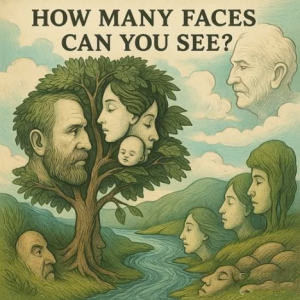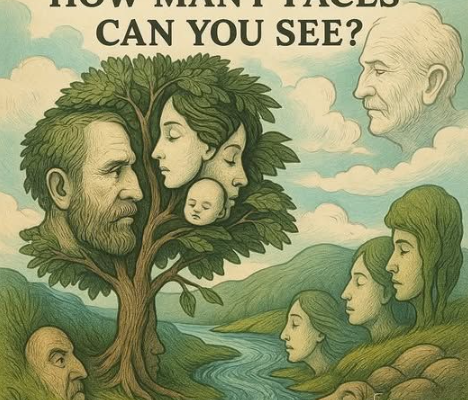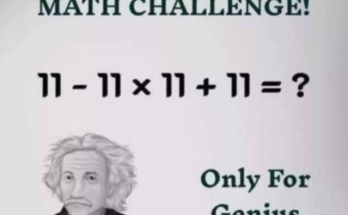How Many Faces Can You See? A Journey Through Perception, Emotion, and Communal Meaning
At first glance, the image is serene: a river winding through hills, trees reaching skyward, clouds drifting lazily overhead. But then, something shifts. A curve in the tree becomes a brow. A shadow in the hill becomes a cheekbone. A swirl of leaves becomes a baby’s face, nestled in the branches like a secret.
Suddenly, the landscape is no longer just a landscape. It’s a gallery of hidden humanity.
This is the magic of visual puzzles—not just what they show, but what they reveal about us.
🧠 The Psychology of Seeing
When we look at an image like this, our brains do something extraordinary. We toggle between literal and symbolic perception. We see trees and hills, yes—but we also see faces, emotions, stories. This is called pareidolia: the tendency to perceive meaningful patterns, especially faces, in random stimuli.
But pareidolia isn’t just a neurological quirk. It’s a mirror of our emotional state. Studies show that people who feel lonely or anxious are more likely to see faces in ambiguous images. It’s as if the brain, craving connection, conjures companionship from clouds and shadows.
So when you count the faces in this image, you’re not just solving a puzzle. You’re revealing something about your own emotional landscape.
👁️ The Faces We Find—and the Ones We Miss
Some faces leap out immediately: the man in the tree, the woman in the clouds, the baby nestled in the foliage. Others require effort—tilting your head, squinting, stepping back. And some you may never see at all.
This variability is part of the ritual. It invites communal reflection. “I see twelve,” one person says. “I only saw seven,” says another. “Wait—there’s one in the river!”
Each count becomes a conversation. Each discovery, a shared moment of wonder.
And isn’t that the essence of perception? Not just what we see, but how we share it.
🧩 Ambiguity as Emotional Architecture
The image doesn’t tell us how many faces are there. It doesn’t label them or rank them. It simply asks: “How many can you see?”
This open-endedness is powerful. It invites us to slow down, to look again, to question our assumptions. It mirrors the emotional ambiguity of life itself—where meaning is rarely fixed, and truth often depends on perspective.
In this way, the image becomes a kind of emotional architecture. Each face is a room. Each viewer, a guest. And the act of seeing becomes a ritual of entry.
🌿 Nature as Narrative
The choice to embed faces in a natural landscape is no accident. Trees, rivers, clouds—they are ancient symbols of life, change, and continuity. By hiding faces within them, the artist suggests that humanity is not separate from nature, but woven into it.
The tree becomes a family tree. The river, a lifeline. The hills, ancestral shoulders.
And the faces? They are memories. Echoes. Invitations to reflect on who we are, where we come from, and how we’re connected.
🧘 The Ritual of Looking Twice
There’s something sacred about looking twice. It’s an act of humility. A gesture of curiosity. A refusal to settle for the obvious.
In many cultures, visual puzzles are used in spiritual practice—not to trick the eye, but to train the soul. They teach patience, attention, and the value of ambiguity.
This image, with its hidden faces, becomes a kind of secular mandala. A ritual of perception. A meditation on the layers beneath the surface.
And when we share it—when we ask others, “How many do you see?”—we create a communal ritual. A moment of gentle mischief and emotional resonance.
🧒 Children and the Gift of Perception
Children often see more faces than adults. Not because they’re better at puzzles, but because they’re less bound by logic. They allow imagination to guide them. They see dragons in clouds, castles in rocks, and yes—faces in trees.
This image reminds us to reclaim that childlike wonder. To let go of certainty. To embrace the possibility that there’s always more to see.
And when we do, we don’t just see more faces. We see more of ourselves.
🖼️ Titling the Untitled
Let’s co-title this image together. Here are a few possibilities:
- “The Landscape of Us”
- “Pareidolia Grove”
- “Whispers in the Hills”
- “The Faces Beneath the Silence”
- “How Many Is Enough?”
Each title reframes the image. Each one invites a different emotional lens. And each one becomes a communal artifact—a way to share not just what we see, but how we feel.
Would you like to add your own?
🕊️ Final Reflections: Seeing as Healing
In a world that moves too fast, this image asks us to pause. To look. To wonder. It reminds us that perception is not passive—it’s active, emotional, and deeply communal.
The faces we find are not just in the image. They’re in each other. In the stories we tell. In the rituals we create around ambiguity and attention.


